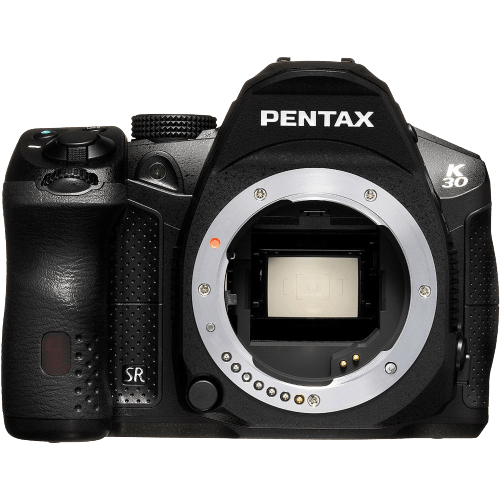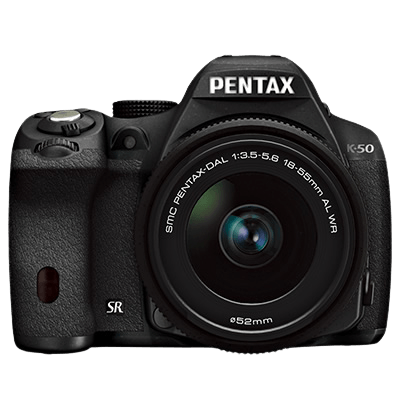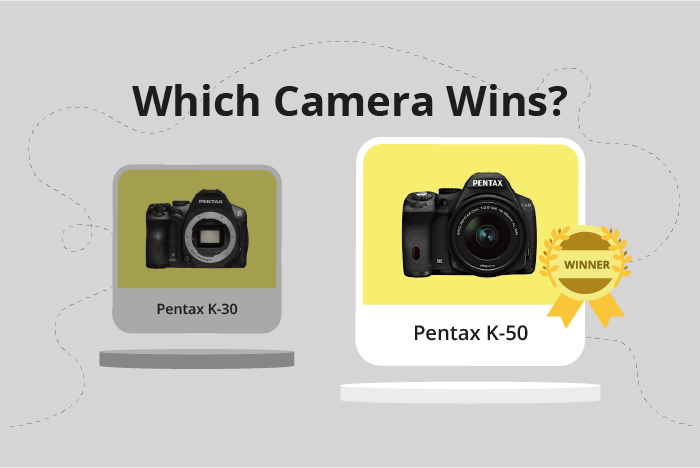Pentax K-30 vs K-50 Comparison
Pentax K-30

Pentax K-50

The Pentax K-50 edges out the Pentax K-30 with a score of 57/100 compared to 56/100. Both cameras are DSLR models, announced in 2012 and 2013 respectively. They share identical dimensions and weight, measuring 130 x 97 x 71mm and weighing 650g.
The K-50 has a slightly higher score due to its improved performance in certain areas. However, the K-30 also has its advantages, such as a lower launch price of $470 compared to the K-50’s $599.
Taking these factors into account, the Pentax K-50 is a marginally better camera, but the K-30 remains a viable option for those seeking a more affordable option.
Pentax K-30 vs K-50 Overview and Optics
The Pentax K-50 takes the lead in optics with a score of 62/100, compared to the Pentax K-30’s score of 60/100. Both cameras share several optical specifications, including 16.3 megapixels for the K-30 and 16.28 megapixels for the K-50, a shooting speed of 6, a CMOS sensor type, Prime M processor, a DXOMARK score of 79 for the sensor, an APS-C sensor size, Pentax KAF lens mount, and image stabilization.
The Pentax K-50’s higher optics score comes from its marginally larger megapixel count, which offers slightly better image quality. This advantage is minimal, but it does give the K-50 an edge in capturing finer details and producing larger prints.
On the other hand, the Pentax K-30’s optics are not significantly inferior to the K-50’s, as both cameras share many of the same specifications. The K-30’s slightly lower megapixel count does not drastically affect its overall image quality, and users may not notice a substantial difference in performance.
In comparing the optics of the Pentax K-30 and K-50, it’s clear that the K-50 has a minor advantage due to its slightly higher megapixel count. However, the K-30 remains a strong contender with its nearly identical specifications. The choice between these two cameras ultimately comes down to personal preference and specific needs, as both offer excellent image quality and performance.
Pentax K-30 vs K-50 Video Performance
The Pentax K-30 and the Pentax K-50 both have a video score of 57/100, indicating no clear winner between the two cameras in terms of video capabilities. They share several common specifications in this regard.
Both cameras have a maximum video resolution of Full HD and can record videos at a size of 1920 x 1080 pixels. They also have the same maximum video frame rate of 30 frames per second (fps). Additionally, both cameras come with built-in time-lapse functionality, which is an attractive feature for capturing events that unfold over a longer period.
Since the video scores and specifications are identical, there is not a specific aspect that makes one camera better than the other in terms of video performance. They both provide similar video quality and features, making them equally suitable for users interested in capturing high-quality videos.
However, it is worth noting that the shared specifications do not necessarily mean that the cameras excel in video performance. With a score of 57/100, it is clear that there is room for improvement in both models. Users looking for exceptional video quality may need to consider other options or newer models with more advanced video capabilities.
In conclusion, the Pentax K-30 and the Pentax K-50 are evenly matched in terms of video capabilities, with no clear winner between them. While they share several useful features, such as Full HD resolution, 30fps frame rate, and built-in time-lapse functionality, their video performance may not be sufficient for users seeking top-notch video quality.
Pentax K-30 vs K-50 Features and Benefits
The Pentax K-30 and Pentax K-50 both have a feature score of 54/100, making them equal in this aspect. They share many specifications, such as a 3-inch screen size and a screen resolution of 921,000 dots. Neither camera has a touchscreen, flip screen, GPS, WIFI, or Bluetooth.
Despite having the same feature score, the Pentax K-30 has certain advantages over the K-50. Unfortunately, the specifications provided do not reveal any distinct advantages for the K-30. Therefore, based on the information given, the K-30 does not outperform the K-50 in any specific area.
On the other hand, the Pentax K-50 also possesses no unique advantages over the K-30, as the specifications provided are identical for both cameras. Consequently, the K-50 does not surpass the K-30 in any particular feature.
Given that both cameras have the same feature score and identical specifications, neither camera can be declared the winner based on the information provided. Buyers should consider other aspects, such as price, design, and personal preferences, when deciding between the Pentax K-30 and Pentax K-50.
Pentax K-30 vs K-50 Storage and Battery
The Pentax K-30 and the Pentax K-50 both score 24/100 in storage and battery, making them equal in this aspect. Both cameras have a single memory card slot and accept SD, SDHC, and SDXC cards. They also share the same battery life of 410 shots and use the D-LI109 battery type. Neither camera offers USB charging.
Despite their equal scores, each camera has its own strengths in storage and battery. The Pentax K-30 excels in its compatibility with various memory card types, ensuring that users have a wide range of options to choose from. On the other hand, the Pentax K-50 boasts a consistent battery life that allows photographers to capture a substantial number of images before needing to recharge.
However, both cameras lack USB charging, which could be a disadvantage for users who prefer to charge their devices through this method. Regardless, the Pentax K-30 and K-50 are evenly matched in terms of storage and battery, making either camera a reliable choice for photographers in need of a dependable device.
Pentax K-30 vs K-50 – Our Verdict
Are you still undecided about which camera is right for you? Have a look at these popular comparisons that feature the Pentax K-30 or the Pentax K-50:

